Exploring Communication Barriers and Patient Outcomes in Nursing
VerifiedAdded on 2022/09/23
|18
|4723
|25
Report
AI Summary
This research proposal examines the impact of communication barriers in nursing on patient outcomes. It begins with an introduction highlighting the importance of effective nurse-patient communication and the prevalence of communication failures. The background and problem statement discuss various communication barriers, such as language differences and workload, and their adverse effects, including patient dissatisfaction and adverse events. A literature review explores existing research on communication barriers, including studies on nurse-patient relationships and the impact of communication on patient care issues. The purpose of the research is to identify the consequences of communication gaps in nursing practice on patient outcomes and quality of care, addressing gaps in previous research. The proposed research design is a descriptive qualitative study, with the potential for future educational and training initiatives to support nurses. The study aims to gather insights from both nurses and clinical managers regarding the impact of communication gaps. The anticipated outcomes include identifying patient-related, nursing staff-related, and organizational barriers, leading to recommendations for improved communication and patient safety. The study highlights the importance of improving communication skills and fostering a patient-centered communication culture within healthcare settings.
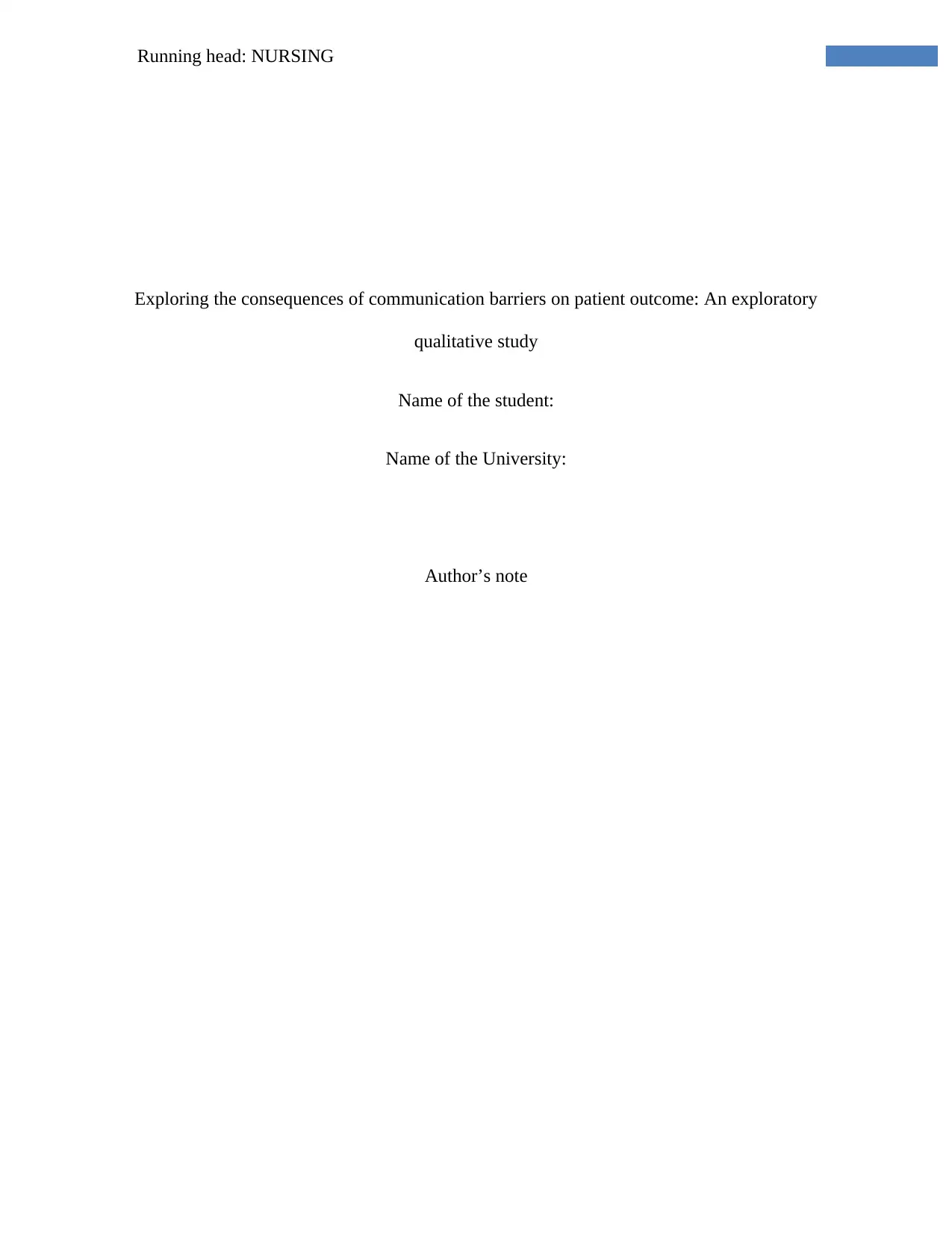
Running head: NURSING
Exploring the consequences of communication barriers on patient outcome: An exploratory
qualitative study
Name of the student:
Name of the University:
Author’s note
Exploring the consequences of communication barriers on patient outcome: An exploratory
qualitative study
Name of the student:
Name of the University:
Author’s note
Paraphrase This Document
Need a fresh take? Get an instant paraphrase of this document with our AI Paraphraser
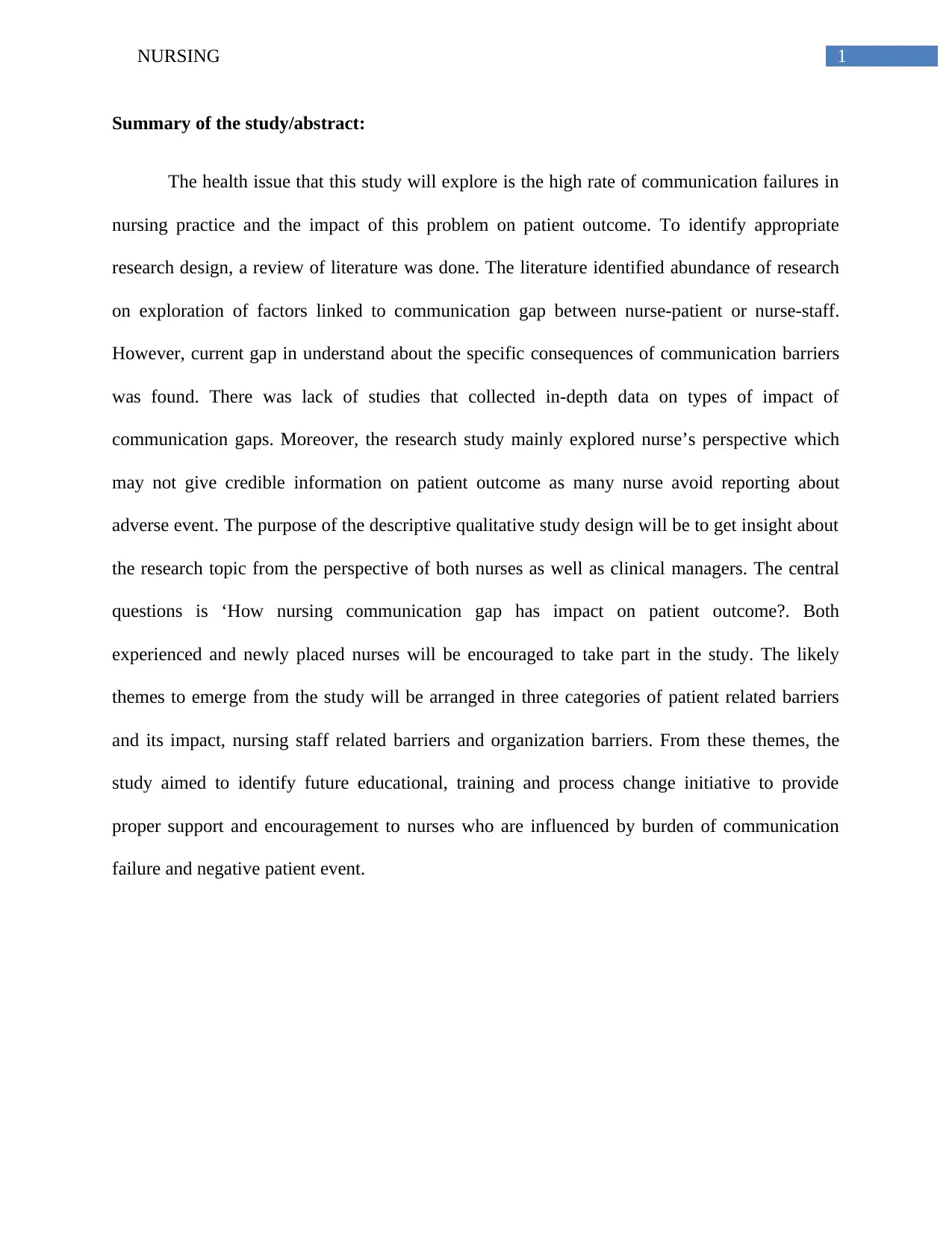
1NURSING
Summary of the study/abstract:
The health issue that this study will explore is the high rate of communication failures in
nursing practice and the impact of this problem on patient outcome. To identify appropriate
research design, a review of literature was done. The literature identified abundance of research
on exploration of factors linked to communication gap between nurse-patient or nurse-staff.
However, current gap in understand about the specific consequences of communication barriers
was found. There was lack of studies that collected in-depth data on types of impact of
communication gaps. Moreover, the research study mainly explored nurse’s perspective which
may not give credible information on patient outcome as many nurse avoid reporting about
adverse event. The purpose of the descriptive qualitative study design will be to get insight about
the research topic from the perspective of both nurses as well as clinical managers. The central
questions is ‘How nursing communication gap has impact on patient outcome?. Both
experienced and newly placed nurses will be encouraged to take part in the study. The likely
themes to emerge from the study will be arranged in three categories of patient related barriers
and its impact, nursing staff related barriers and organization barriers. From these themes, the
study aimed to identify future educational, training and process change initiative to provide
proper support and encouragement to nurses who are influenced by burden of communication
failure and negative patient event.
Summary of the study/abstract:
The health issue that this study will explore is the high rate of communication failures in
nursing practice and the impact of this problem on patient outcome. To identify appropriate
research design, a review of literature was done. The literature identified abundance of research
on exploration of factors linked to communication gap between nurse-patient or nurse-staff.
However, current gap in understand about the specific consequences of communication barriers
was found. There was lack of studies that collected in-depth data on types of impact of
communication gaps. Moreover, the research study mainly explored nurse’s perspective which
may not give credible information on patient outcome as many nurse avoid reporting about
adverse event. The purpose of the descriptive qualitative study design will be to get insight about
the research topic from the perspective of both nurses as well as clinical managers. The central
questions is ‘How nursing communication gap has impact on patient outcome?. Both
experienced and newly placed nurses will be encouraged to take part in the study. The likely
themes to emerge from the study will be arranged in three categories of patient related barriers
and its impact, nursing staff related barriers and organization barriers. From these themes, the
study aimed to identify future educational, training and process change initiative to provide
proper support and encouragement to nurses who are influenced by burden of communication
failure and negative patient event.
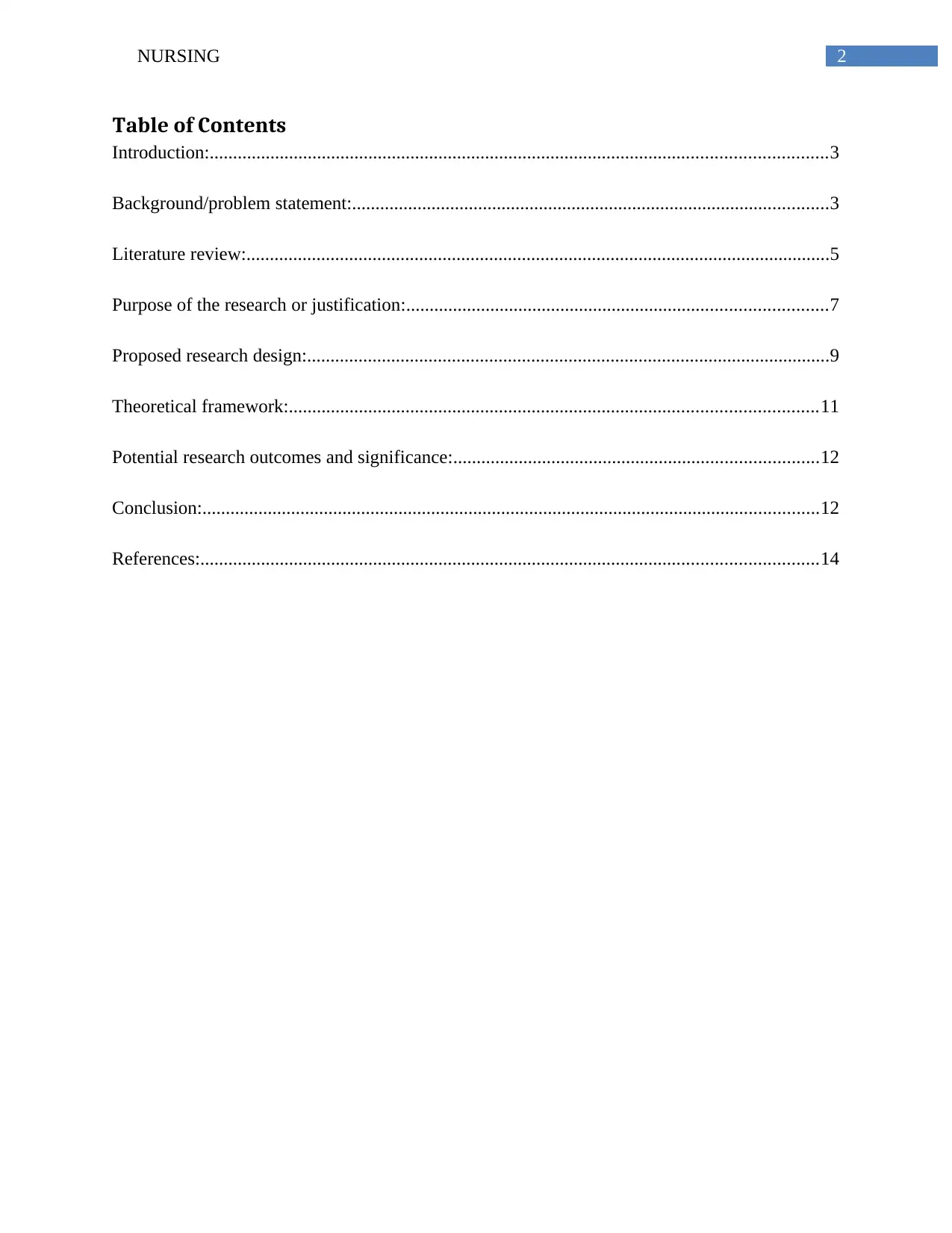
2NURSING
Table of Contents
Introduction:....................................................................................................................................3
Background/problem statement:......................................................................................................3
Literature review:.............................................................................................................................5
Purpose of the research or justification:..........................................................................................7
Proposed research design:................................................................................................................9
Theoretical framework:.................................................................................................................11
Potential research outcomes and significance:..............................................................................12
Conclusion:....................................................................................................................................12
References:....................................................................................................................................14
Table of Contents
Introduction:....................................................................................................................................3
Background/problem statement:......................................................................................................3
Literature review:.............................................................................................................................5
Purpose of the research or justification:..........................................................................................7
Proposed research design:................................................................................................................9
Theoretical framework:.................................................................................................................11
Potential research outcomes and significance:..............................................................................12
Conclusion:....................................................................................................................................12
References:....................................................................................................................................14
⊘ This is a preview!⊘
Do you want full access?
Subscribe today to unlock all pages.

Trusted by 1+ million students worldwide
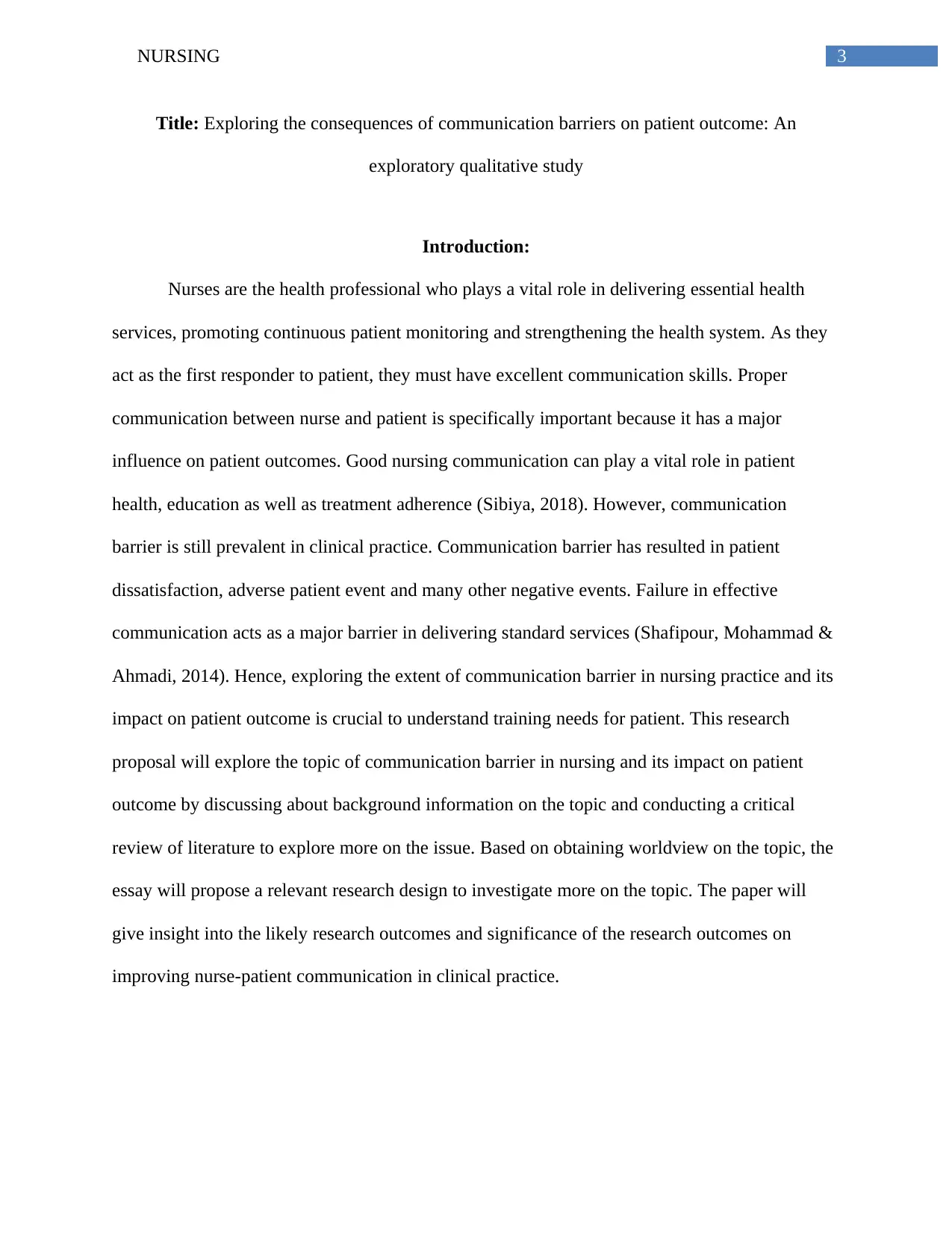
3NURSING
Title: Exploring the consequences of communication barriers on patient outcome: An
exploratory qualitative study
Introduction:
Nurses are the health professional who plays a vital role in delivering essential health
services, promoting continuous patient monitoring and strengthening the health system. As they
act as the first responder to patient, they must have excellent communication skills. Proper
communication between nurse and patient is specifically important because it has a major
influence on patient outcomes. Good nursing communication can play a vital role in patient
health, education as well as treatment adherence (Sibiya, 2018). However, communication
barrier is still prevalent in clinical practice. Communication barrier has resulted in patient
dissatisfaction, adverse patient event and many other negative events. Failure in effective
communication acts as a major barrier in delivering standard services (Shafipour, Mohammad &
Ahmadi, 2014). Hence, exploring the extent of communication barrier in nursing practice and its
impact on patient outcome is crucial to understand training needs for patient. This research
proposal will explore the topic of communication barrier in nursing and its impact on patient
outcome by discussing about background information on the topic and conducting a critical
review of literature to explore more on the issue. Based on obtaining worldview on the topic, the
essay will propose a relevant research design to investigate more on the topic. The paper will
give insight into the likely research outcomes and significance of the research outcomes on
improving nurse-patient communication in clinical practice.
Title: Exploring the consequences of communication barriers on patient outcome: An
exploratory qualitative study
Introduction:
Nurses are the health professional who plays a vital role in delivering essential health
services, promoting continuous patient monitoring and strengthening the health system. As they
act as the first responder to patient, they must have excellent communication skills. Proper
communication between nurse and patient is specifically important because it has a major
influence on patient outcomes. Good nursing communication can play a vital role in patient
health, education as well as treatment adherence (Sibiya, 2018). However, communication
barrier is still prevalent in clinical practice. Communication barrier has resulted in patient
dissatisfaction, adverse patient event and many other negative events. Failure in effective
communication acts as a major barrier in delivering standard services (Shafipour, Mohammad &
Ahmadi, 2014). Hence, exploring the extent of communication barrier in nursing practice and its
impact on patient outcome is crucial to understand training needs for patient. This research
proposal will explore the topic of communication barrier in nursing and its impact on patient
outcome by discussing about background information on the topic and conducting a critical
review of literature to explore more on the issue. Based on obtaining worldview on the topic, the
essay will propose a relevant research design to investigate more on the topic. The paper will
give insight into the likely research outcomes and significance of the research outcomes on
improving nurse-patient communication in clinical practice.
Paraphrase This Document
Need a fresh take? Get an instant paraphrase of this document with our AI Paraphraser
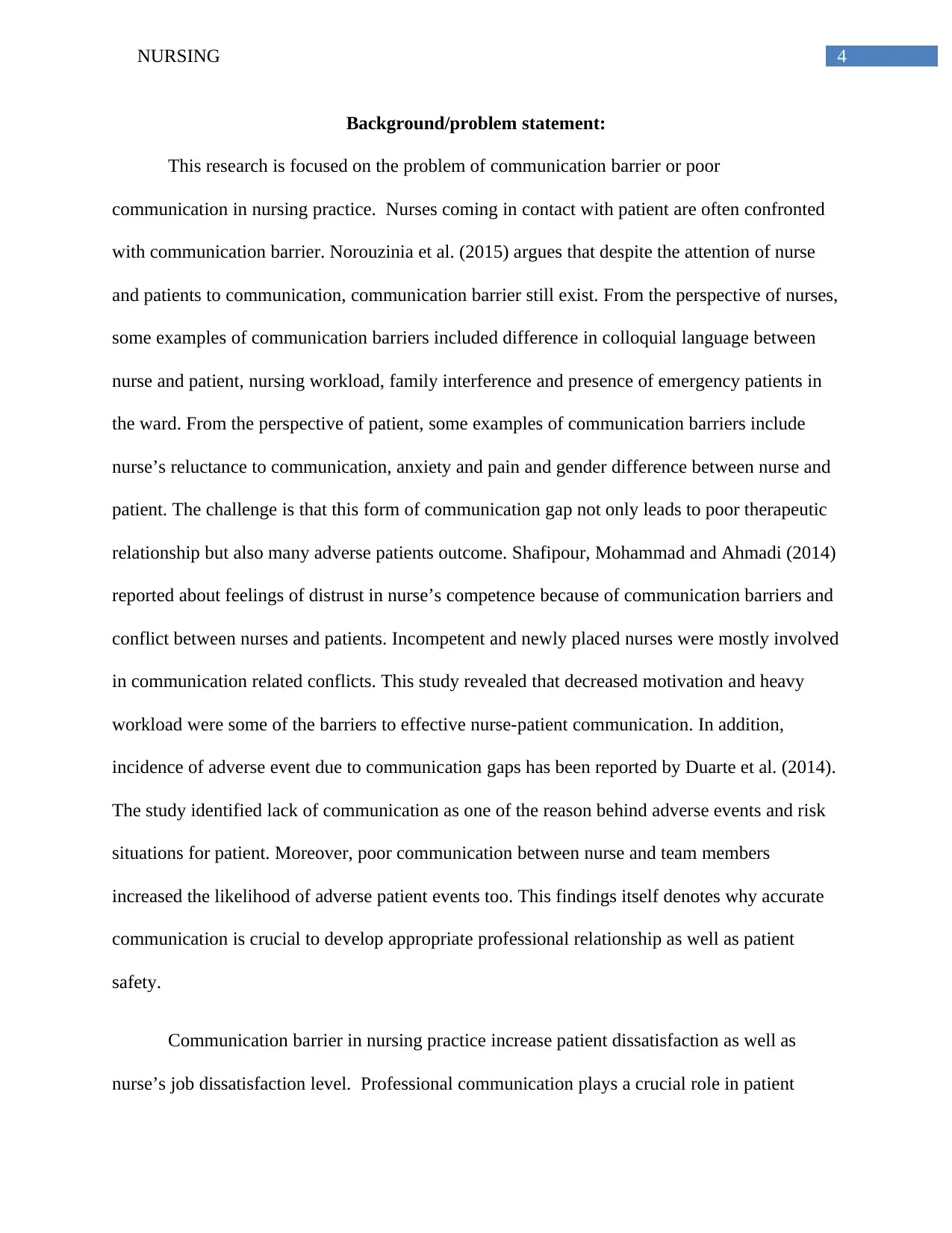
4NURSING
Background/problem statement:
This research is focused on the problem of communication barrier or poor
communication in nursing practice. Nurses coming in contact with patient are often confronted
with communication barrier. Norouzinia et al. (2015) argues that despite the attention of nurse
and patients to communication, communication barrier still exist. From the perspective of nurses,
some examples of communication barriers included difference in colloquial language between
nurse and patient, nursing workload, family interference and presence of emergency patients in
the ward. From the perspective of patient, some examples of communication barriers include
nurse’s reluctance to communication, anxiety and pain and gender difference between nurse and
patient. The challenge is that this form of communication gap not only leads to poor therapeutic
relationship but also many adverse patients outcome. Shafipour, Mohammad and Ahmadi (2014)
reported about feelings of distrust in nurse’s competence because of communication barriers and
conflict between nurses and patients. Incompetent and newly placed nurses were mostly involved
in communication related conflicts. This study revealed that decreased motivation and heavy
workload were some of the barriers to effective nurse-patient communication. In addition,
incidence of adverse event due to communication gaps has been reported by Duarte et al. (2014).
The study identified lack of communication as one of the reason behind adverse events and risk
situations for patient. Moreover, poor communication between nurse and team members
increased the likelihood of adverse patient events too. This findings itself denotes why accurate
communication is crucial to develop appropriate professional relationship as well as patient
safety.
Communication barrier in nursing practice increase patient dissatisfaction as well as
nurse’s job dissatisfaction level. Professional communication plays a crucial role in patient
Background/problem statement:
This research is focused on the problem of communication barrier or poor
communication in nursing practice. Nurses coming in contact with patient are often confronted
with communication barrier. Norouzinia et al. (2015) argues that despite the attention of nurse
and patients to communication, communication barrier still exist. From the perspective of nurses,
some examples of communication barriers included difference in colloquial language between
nurse and patient, nursing workload, family interference and presence of emergency patients in
the ward. From the perspective of patient, some examples of communication barriers include
nurse’s reluctance to communication, anxiety and pain and gender difference between nurse and
patient. The challenge is that this form of communication gap not only leads to poor therapeutic
relationship but also many adverse patients outcome. Shafipour, Mohammad and Ahmadi (2014)
reported about feelings of distrust in nurse’s competence because of communication barriers and
conflict between nurses and patients. Incompetent and newly placed nurses were mostly involved
in communication related conflicts. This study revealed that decreased motivation and heavy
workload were some of the barriers to effective nurse-patient communication. In addition,
incidence of adverse event due to communication gaps has been reported by Duarte et al. (2014).
The study identified lack of communication as one of the reason behind adverse events and risk
situations for patient. Moreover, poor communication between nurse and team members
increased the likelihood of adverse patient events too. This findings itself denotes why accurate
communication is crucial to develop appropriate professional relationship as well as patient
safety.
Communication barrier in nursing practice increase patient dissatisfaction as well as
nurse’s job dissatisfaction level. Professional communication plays a crucial role in patient
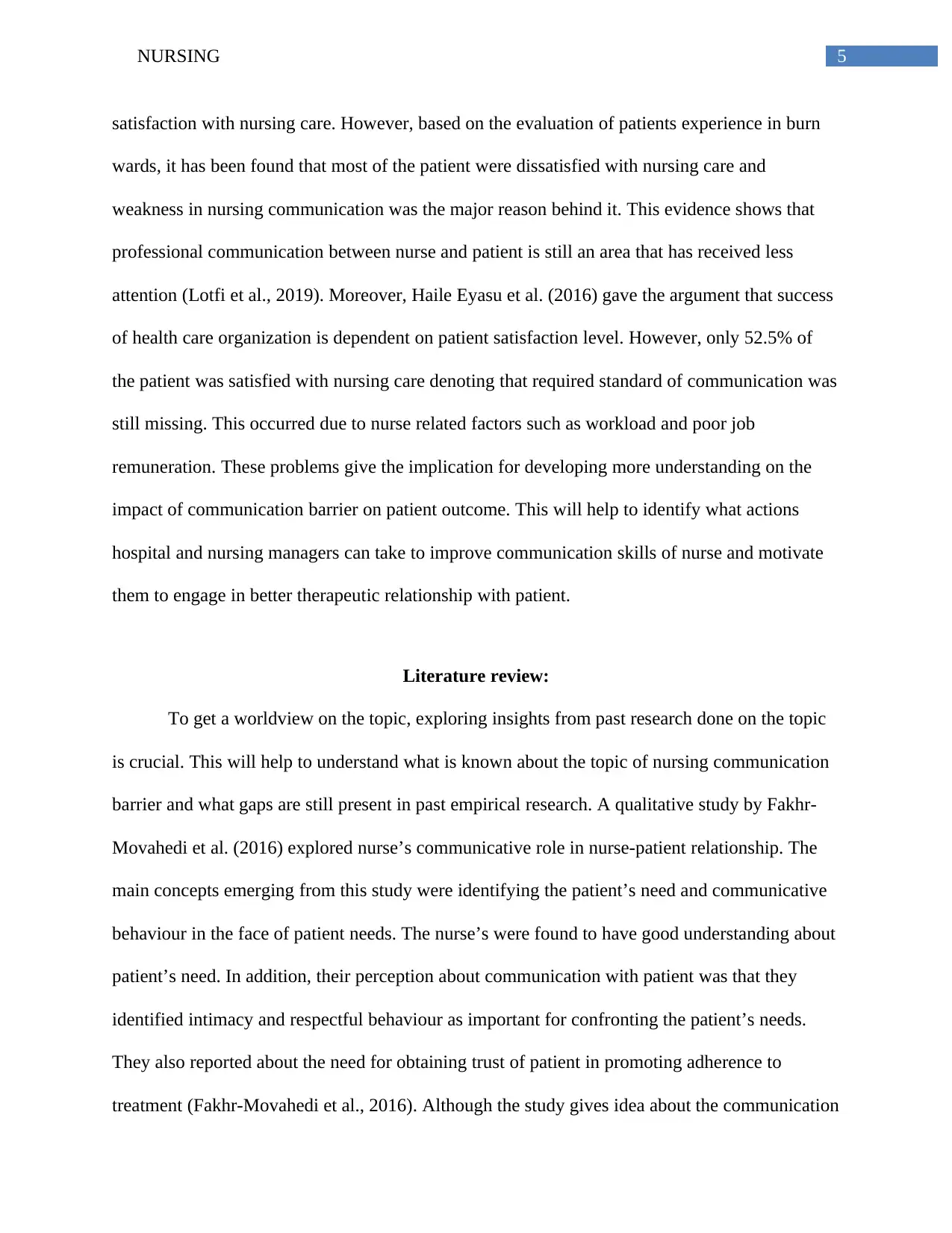
5NURSING
satisfaction with nursing care. However, based on the evaluation of patients experience in burn
wards, it has been found that most of the patient were dissatisfied with nursing care and
weakness in nursing communication was the major reason behind it. This evidence shows that
professional communication between nurse and patient is still an area that has received less
attention (Lotfi et al., 2019). Moreover, Haile Eyasu et al. (2016) gave the argument that success
of health care organization is dependent on patient satisfaction level. However, only 52.5% of
the patient was satisfied with nursing care denoting that required standard of communication was
still missing. This occurred due to nurse related factors such as workload and poor job
remuneration. These problems give the implication for developing more understanding on the
impact of communication barrier on patient outcome. This will help to identify what actions
hospital and nursing managers can take to improve communication skills of nurse and motivate
them to engage in better therapeutic relationship with patient.
Literature review:
To get a worldview on the topic, exploring insights from past research done on the topic
is crucial. This will help to understand what is known about the topic of nursing communication
barrier and what gaps are still present in past empirical research. A qualitative study by Fakhr-
Movahedi et al. (2016) explored nurse’s communicative role in nurse-patient relationship. The
main concepts emerging from this study were identifying the patient’s need and communicative
behaviour in the face of patient needs. The nurse’s were found to have good understanding about
patient’s need. In addition, their perception about communication with patient was that they
identified intimacy and respectful behaviour as important for confronting the patient’s needs.
They also reported about the need for obtaining trust of patient in promoting adherence to
treatment (Fakhr-Movahedi et al., 2016). Although the study gives idea about the communication
satisfaction with nursing care. However, based on the evaluation of patients experience in burn
wards, it has been found that most of the patient were dissatisfied with nursing care and
weakness in nursing communication was the major reason behind it. This evidence shows that
professional communication between nurse and patient is still an area that has received less
attention (Lotfi et al., 2019). Moreover, Haile Eyasu et al. (2016) gave the argument that success
of health care organization is dependent on patient satisfaction level. However, only 52.5% of
the patient was satisfied with nursing care denoting that required standard of communication was
still missing. This occurred due to nurse related factors such as workload and poor job
remuneration. These problems give the implication for developing more understanding on the
impact of communication barrier on patient outcome. This will help to identify what actions
hospital and nursing managers can take to improve communication skills of nurse and motivate
them to engage in better therapeutic relationship with patient.
Literature review:
To get a worldview on the topic, exploring insights from past research done on the topic
is crucial. This will help to understand what is known about the topic of nursing communication
barrier and what gaps are still present in past empirical research. A qualitative study by Fakhr-
Movahedi et al. (2016) explored nurse’s communicative role in nurse-patient relationship. The
main concepts emerging from this study were identifying the patient’s need and communicative
behaviour in the face of patient needs. The nurse’s were found to have good understanding about
patient’s need. In addition, their perception about communication with patient was that they
identified intimacy and respectful behaviour as important for confronting the patient’s needs.
They also reported about the need for obtaining trust of patient in promoting adherence to
treatment (Fakhr-Movahedi et al., 2016). Although the study gives idea about the communication
⊘ This is a preview!⊘
Do you want full access?
Subscribe today to unlock all pages.

Trusted by 1+ million students worldwide
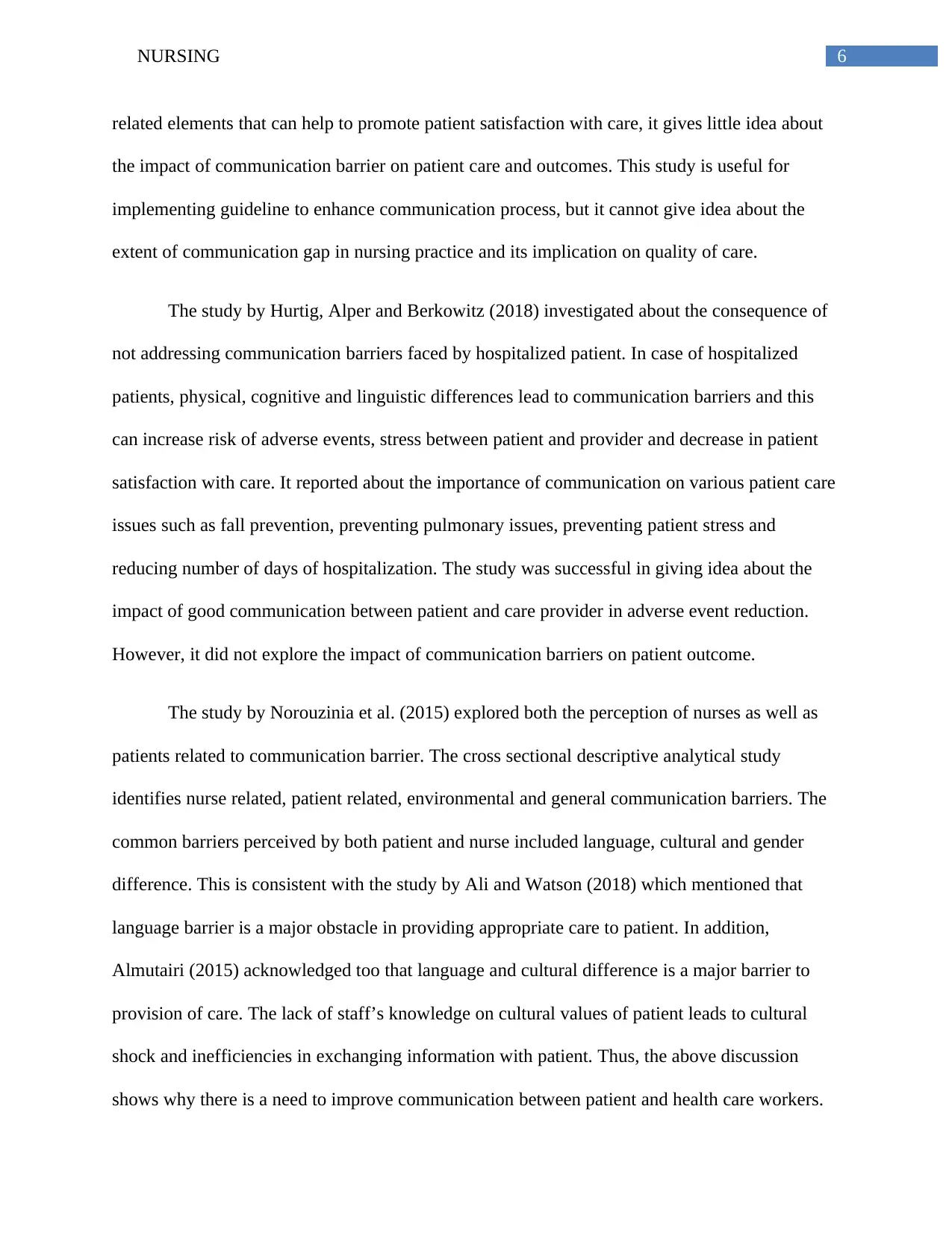
6NURSING
related elements that can help to promote patient satisfaction with care, it gives little idea about
the impact of communication barrier on patient care and outcomes. This study is useful for
implementing guideline to enhance communication process, but it cannot give idea about the
extent of communication gap in nursing practice and its implication on quality of care.
The study by Hurtig, Alper and Berkowitz (2018) investigated about the consequence of
not addressing communication barriers faced by hospitalized patient. In case of hospitalized
patients, physical, cognitive and linguistic differences lead to communication barriers and this
can increase risk of adverse events, stress between patient and provider and decrease in patient
satisfaction with care. It reported about the importance of communication on various patient care
issues such as fall prevention, preventing pulmonary issues, preventing patient stress and
reducing number of days of hospitalization. The study was successful in giving idea about the
impact of good communication between patient and care provider in adverse event reduction.
However, it did not explore the impact of communication barriers on patient outcome.
The study by Norouzinia et al. (2015) explored both the perception of nurses as well as
patients related to communication barrier. The cross sectional descriptive analytical study
identifies nurse related, patient related, environmental and general communication barriers. The
common barriers perceived by both patient and nurse included language, cultural and gender
difference. This is consistent with the study by Ali and Watson (2018) which mentioned that
language barrier is a major obstacle in providing appropriate care to patient. In addition,
Almutairi (2015) acknowledged too that language and cultural difference is a major barrier to
provision of care. The lack of staff’s knowledge on cultural values of patient leads to cultural
shock and inefficiencies in exchanging information with patient. Thus, the above discussion
shows why there is a need to improve communication between patient and health care workers.
related elements that can help to promote patient satisfaction with care, it gives little idea about
the impact of communication barrier on patient care and outcomes. This study is useful for
implementing guideline to enhance communication process, but it cannot give idea about the
extent of communication gap in nursing practice and its implication on quality of care.
The study by Hurtig, Alper and Berkowitz (2018) investigated about the consequence of
not addressing communication barriers faced by hospitalized patient. In case of hospitalized
patients, physical, cognitive and linguistic differences lead to communication barriers and this
can increase risk of adverse events, stress between patient and provider and decrease in patient
satisfaction with care. It reported about the importance of communication on various patient care
issues such as fall prevention, preventing pulmonary issues, preventing patient stress and
reducing number of days of hospitalization. The study was successful in giving idea about the
impact of good communication between patient and care provider in adverse event reduction.
However, it did not explore the impact of communication barriers on patient outcome.
The study by Norouzinia et al. (2015) explored both the perception of nurses as well as
patients related to communication barrier. The cross sectional descriptive analytical study
identifies nurse related, patient related, environmental and general communication barriers. The
common barriers perceived by both patient and nurse included language, cultural and gender
difference. This is consistent with the study by Ali and Watson (2018) which mentioned that
language barrier is a major obstacle in providing appropriate care to patient. In addition,
Almutairi (2015) acknowledged too that language and cultural difference is a major barrier to
provision of care. The lack of staff’s knowledge on cultural values of patient leads to cultural
shock and inefficiencies in exchanging information with patient. Thus, the above discussion
shows why there is a need to improve communication between patient and health care workers.
Paraphrase This Document
Need a fresh take? Get an instant paraphrase of this document with our AI Paraphraser
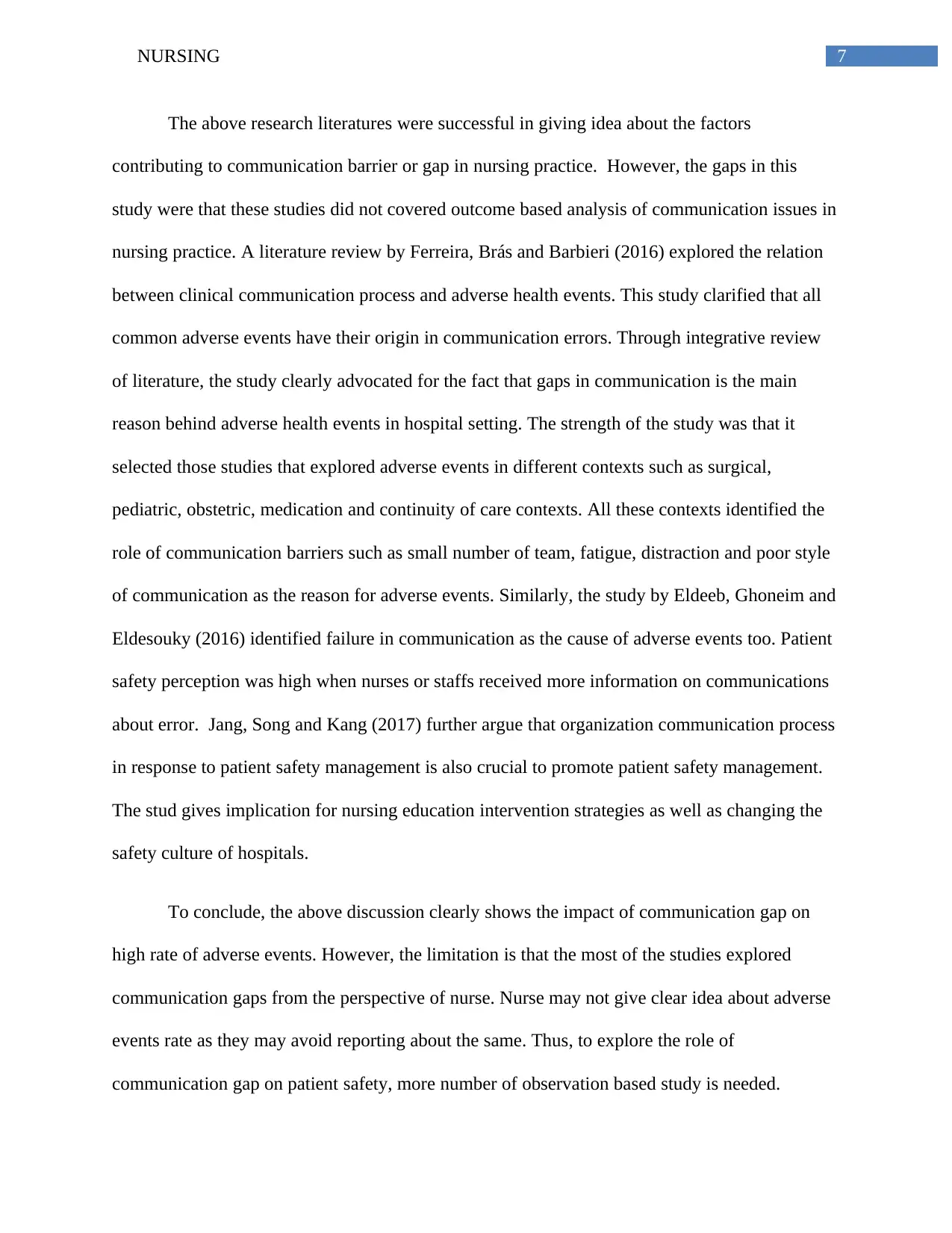
7NURSING
The above research literatures were successful in giving idea about the factors
contributing to communication barrier or gap in nursing practice. However, the gaps in this
study were that these studies did not covered outcome based analysis of communication issues in
nursing practice. A literature review by Ferreira, Brás and Barbieri (2016) explored the relation
between clinical communication process and adverse health events. This study clarified that all
common adverse events have their origin in communication errors. Through integrative review
of literature, the study clearly advocated for the fact that gaps in communication is the main
reason behind adverse health events in hospital setting. The strength of the study was that it
selected those studies that explored adverse events in different contexts such as surgical,
pediatric, obstetric, medication and continuity of care contexts. All these contexts identified the
role of communication barriers such as small number of team, fatigue, distraction and poor style
of communication as the reason for adverse events. Similarly, the study by Eldeeb, Ghoneim and
Eldesouky (2016) identified failure in communication as the cause of adverse events too. Patient
safety perception was high when nurses or staffs received more information on communications
about error. Jang, Song and Kang (2017) further argue that organization communication process
in response to patient safety management is also crucial to promote patient safety management.
The stud gives implication for nursing education intervention strategies as well as changing the
safety culture of hospitals.
To conclude, the above discussion clearly shows the impact of communication gap on
high rate of adverse events. However, the limitation is that the most of the studies explored
communication gaps from the perspective of nurse. Nurse may not give clear idea about adverse
events rate as they may avoid reporting about the same. Thus, to explore the role of
communication gap on patient safety, more number of observation based study is needed.
The above research literatures were successful in giving idea about the factors
contributing to communication barrier or gap in nursing practice. However, the gaps in this
study were that these studies did not covered outcome based analysis of communication issues in
nursing practice. A literature review by Ferreira, Brás and Barbieri (2016) explored the relation
between clinical communication process and adverse health events. This study clarified that all
common adverse events have their origin in communication errors. Through integrative review
of literature, the study clearly advocated for the fact that gaps in communication is the main
reason behind adverse health events in hospital setting. The strength of the study was that it
selected those studies that explored adverse events in different contexts such as surgical,
pediatric, obstetric, medication and continuity of care contexts. All these contexts identified the
role of communication barriers such as small number of team, fatigue, distraction and poor style
of communication as the reason for adverse events. Similarly, the study by Eldeeb, Ghoneim and
Eldesouky (2016) identified failure in communication as the cause of adverse events too. Patient
safety perception was high when nurses or staffs received more information on communications
about error. Jang, Song and Kang (2017) further argue that organization communication process
in response to patient safety management is also crucial to promote patient safety management.
The stud gives implication for nursing education intervention strategies as well as changing the
safety culture of hospitals.
To conclude, the above discussion clearly shows the impact of communication gap on
high rate of adverse events. However, the limitation is that the most of the studies explored
communication gaps from the perspective of nurse. Nurse may not give clear idea about adverse
events rate as they may avoid reporting about the same. Thus, to explore the role of
communication gap on patient safety, more number of observation based study is needed.
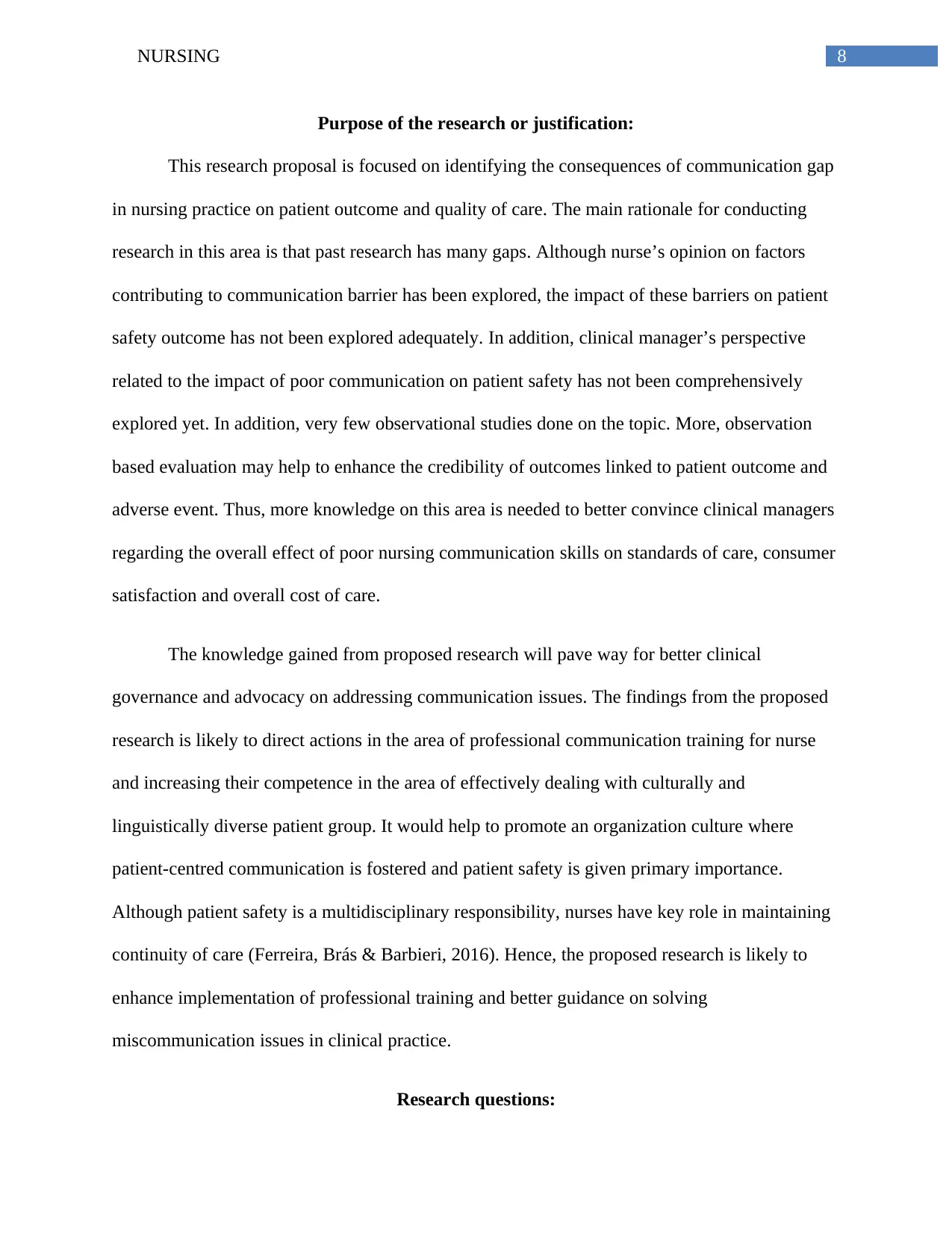
8NURSING
Purpose of the research or justification:
This research proposal is focused on identifying the consequences of communication gap
in nursing practice on patient outcome and quality of care. The main rationale for conducting
research in this area is that past research has many gaps. Although nurse’s opinion on factors
contributing to communication barrier has been explored, the impact of these barriers on patient
safety outcome has not been explored adequately. In addition, clinical manager’s perspective
related to the impact of poor communication on patient safety has not been comprehensively
explored yet. In addition, very few observational studies done on the topic. More, observation
based evaluation may help to enhance the credibility of outcomes linked to patient outcome and
adverse event. Thus, more knowledge on this area is needed to better convince clinical managers
regarding the overall effect of poor nursing communication skills on standards of care, consumer
satisfaction and overall cost of care.
The knowledge gained from proposed research will pave way for better clinical
governance and advocacy on addressing communication issues. The findings from the proposed
research is likely to direct actions in the area of professional communication training for nurse
and increasing their competence in the area of effectively dealing with culturally and
linguistically diverse patient group. It would help to promote an organization culture where
patient-centred communication is fostered and patient safety is given primary importance.
Although patient safety is a multidisciplinary responsibility, nurses have key role in maintaining
continuity of care (Ferreira, Brás & Barbieri, 2016). Hence, the proposed research is likely to
enhance implementation of professional training and better guidance on solving
miscommunication issues in clinical practice.
Research questions:
Purpose of the research or justification:
This research proposal is focused on identifying the consequences of communication gap
in nursing practice on patient outcome and quality of care. The main rationale for conducting
research in this area is that past research has many gaps. Although nurse’s opinion on factors
contributing to communication barrier has been explored, the impact of these barriers on patient
safety outcome has not been explored adequately. In addition, clinical manager’s perspective
related to the impact of poor communication on patient safety has not been comprehensively
explored yet. In addition, very few observational studies done on the topic. More, observation
based evaluation may help to enhance the credibility of outcomes linked to patient outcome and
adverse event. Thus, more knowledge on this area is needed to better convince clinical managers
regarding the overall effect of poor nursing communication skills on standards of care, consumer
satisfaction and overall cost of care.
The knowledge gained from proposed research will pave way for better clinical
governance and advocacy on addressing communication issues. The findings from the proposed
research is likely to direct actions in the area of professional communication training for nurse
and increasing their competence in the area of effectively dealing with culturally and
linguistically diverse patient group. It would help to promote an organization culture where
patient-centred communication is fostered and patient safety is given primary importance.
Although patient safety is a multidisciplinary responsibility, nurses have key role in maintaining
continuity of care (Ferreira, Brás & Barbieri, 2016). Hence, the proposed research is likely to
enhance implementation of professional training and better guidance on solving
miscommunication issues in clinical practice.
Research questions:
⊘ This is a preview!⊘
Do you want full access?
Subscribe today to unlock all pages.

Trusted by 1+ million students worldwide
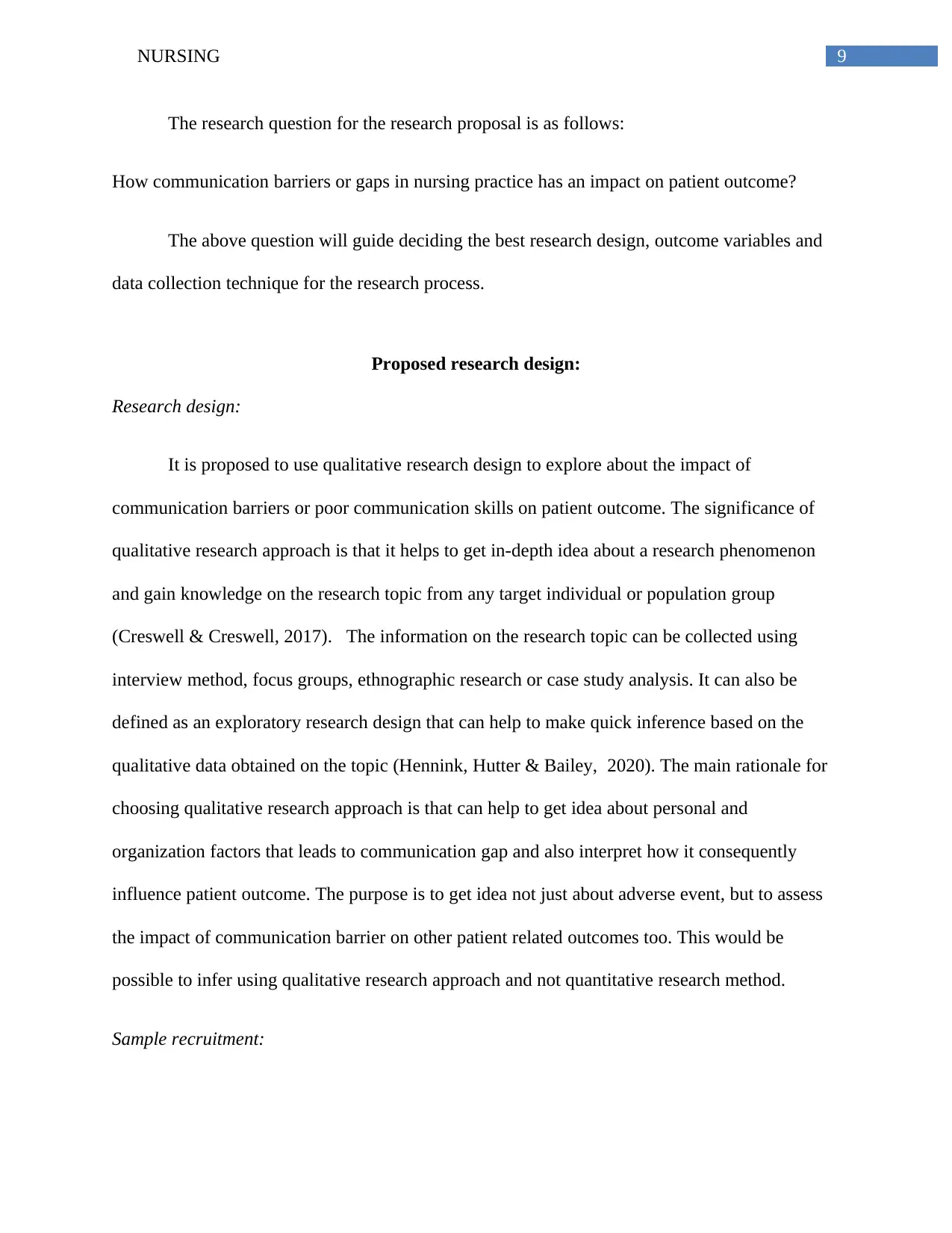
9NURSING
The research question for the research proposal is as follows:
How communication barriers or gaps in nursing practice has an impact on patient outcome?
The above question will guide deciding the best research design, outcome variables and
data collection technique for the research process.
Proposed research design:
Research design:
It is proposed to use qualitative research design to explore about the impact of
communication barriers or poor communication skills on patient outcome. The significance of
qualitative research approach is that it helps to get in-depth idea about a research phenomenon
and gain knowledge on the research topic from any target individual or population group
(Creswell & Creswell, 2017). The information on the research topic can be collected using
interview method, focus groups, ethnographic research or case study analysis. It can also be
defined as an exploratory research design that can help to make quick inference based on the
qualitative data obtained on the topic (Hennink, Hutter & Bailey, 2020). The main rationale for
choosing qualitative research approach is that can help to get idea about personal and
organization factors that leads to communication gap and also interpret how it consequently
influence patient outcome. The purpose is to get idea not just about adverse event, but to assess
the impact of communication barrier on other patient related outcomes too. This would be
possible to infer using qualitative research approach and not quantitative research method.
Sample recruitment:
The research question for the research proposal is as follows:
How communication barriers or gaps in nursing practice has an impact on patient outcome?
The above question will guide deciding the best research design, outcome variables and
data collection technique for the research process.
Proposed research design:
Research design:
It is proposed to use qualitative research design to explore about the impact of
communication barriers or poor communication skills on patient outcome. The significance of
qualitative research approach is that it helps to get in-depth idea about a research phenomenon
and gain knowledge on the research topic from any target individual or population group
(Creswell & Creswell, 2017). The information on the research topic can be collected using
interview method, focus groups, ethnographic research or case study analysis. It can also be
defined as an exploratory research design that can help to make quick inference based on the
qualitative data obtained on the topic (Hennink, Hutter & Bailey, 2020). The main rationale for
choosing qualitative research approach is that can help to get idea about personal and
organization factors that leads to communication gap and also interpret how it consequently
influence patient outcome. The purpose is to get idea not just about adverse event, but to assess
the impact of communication barrier on other patient related outcomes too. This would be
possible to infer using qualitative research approach and not quantitative research method.
Sample recruitment:
Paraphrase This Document
Need a fresh take? Get an instant paraphrase of this document with our AI Paraphraser
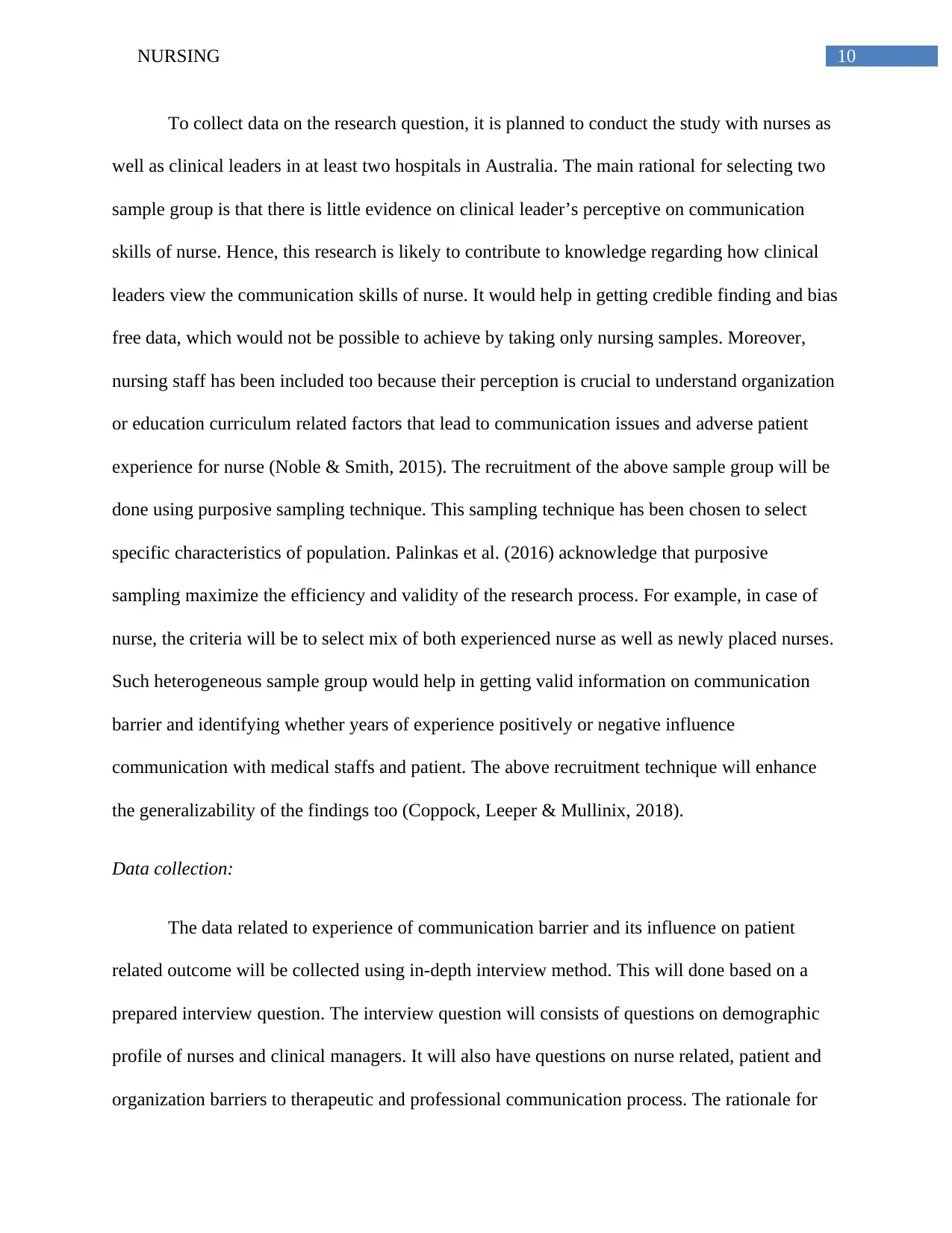
10NURSING
To collect data on the research question, it is planned to conduct the study with nurses as
well as clinical leaders in at least two hospitals in Australia. The main rational for selecting two
sample group is that there is little evidence on clinical leader’s perceptive on communication
skills of nurse. Hence, this research is likely to contribute to knowledge regarding how clinical
leaders view the communication skills of nurse. It would help in getting credible finding and bias
free data, which would not be possible to achieve by taking only nursing samples. Moreover,
nursing staff has been included too because their perception is crucial to understand organization
or education curriculum related factors that lead to communication issues and adverse patient
experience for nurse (Noble & Smith, 2015). The recruitment of the above sample group will be
done using purposive sampling technique. This sampling technique has been chosen to select
specific characteristics of population. Palinkas et al. (2016) acknowledge that purposive
sampling maximize the efficiency and validity of the research process. For example, in case of
nurse, the criteria will be to select mix of both experienced nurse as well as newly placed nurses.
Such heterogeneous sample group would help in getting valid information on communication
barrier and identifying whether years of experience positively or negative influence
communication with medical staffs and patient. The above recruitment technique will enhance
the generalizability of the findings too (Coppock, Leeper & Mullinix, 2018).
Data collection:
The data related to experience of communication barrier and its influence on patient
related outcome will be collected using in-depth interview method. This will done based on a
prepared interview question. The interview question will consists of questions on demographic
profile of nurses and clinical managers. It will also have questions on nurse related, patient and
organization barriers to therapeutic and professional communication process. The rationale for
To collect data on the research question, it is planned to conduct the study with nurses as
well as clinical leaders in at least two hospitals in Australia. The main rational for selecting two
sample group is that there is little evidence on clinical leader’s perceptive on communication
skills of nurse. Hence, this research is likely to contribute to knowledge regarding how clinical
leaders view the communication skills of nurse. It would help in getting credible finding and bias
free data, which would not be possible to achieve by taking only nursing samples. Moreover,
nursing staff has been included too because their perception is crucial to understand organization
or education curriculum related factors that lead to communication issues and adverse patient
experience for nurse (Noble & Smith, 2015). The recruitment of the above sample group will be
done using purposive sampling technique. This sampling technique has been chosen to select
specific characteristics of population. Palinkas et al. (2016) acknowledge that purposive
sampling maximize the efficiency and validity of the research process. For example, in case of
nurse, the criteria will be to select mix of both experienced nurse as well as newly placed nurses.
Such heterogeneous sample group would help in getting valid information on communication
barrier and identifying whether years of experience positively or negative influence
communication with medical staffs and patient. The above recruitment technique will enhance
the generalizability of the findings too (Coppock, Leeper & Mullinix, 2018).
Data collection:
The data related to experience of communication barrier and its influence on patient
related outcome will be collected using in-depth interview method. This will done based on a
prepared interview question. The interview question will consists of questions on demographic
profile of nurses and clinical managers. It will also have questions on nurse related, patient and
organization barriers to therapeutic and professional communication process. The rationale for
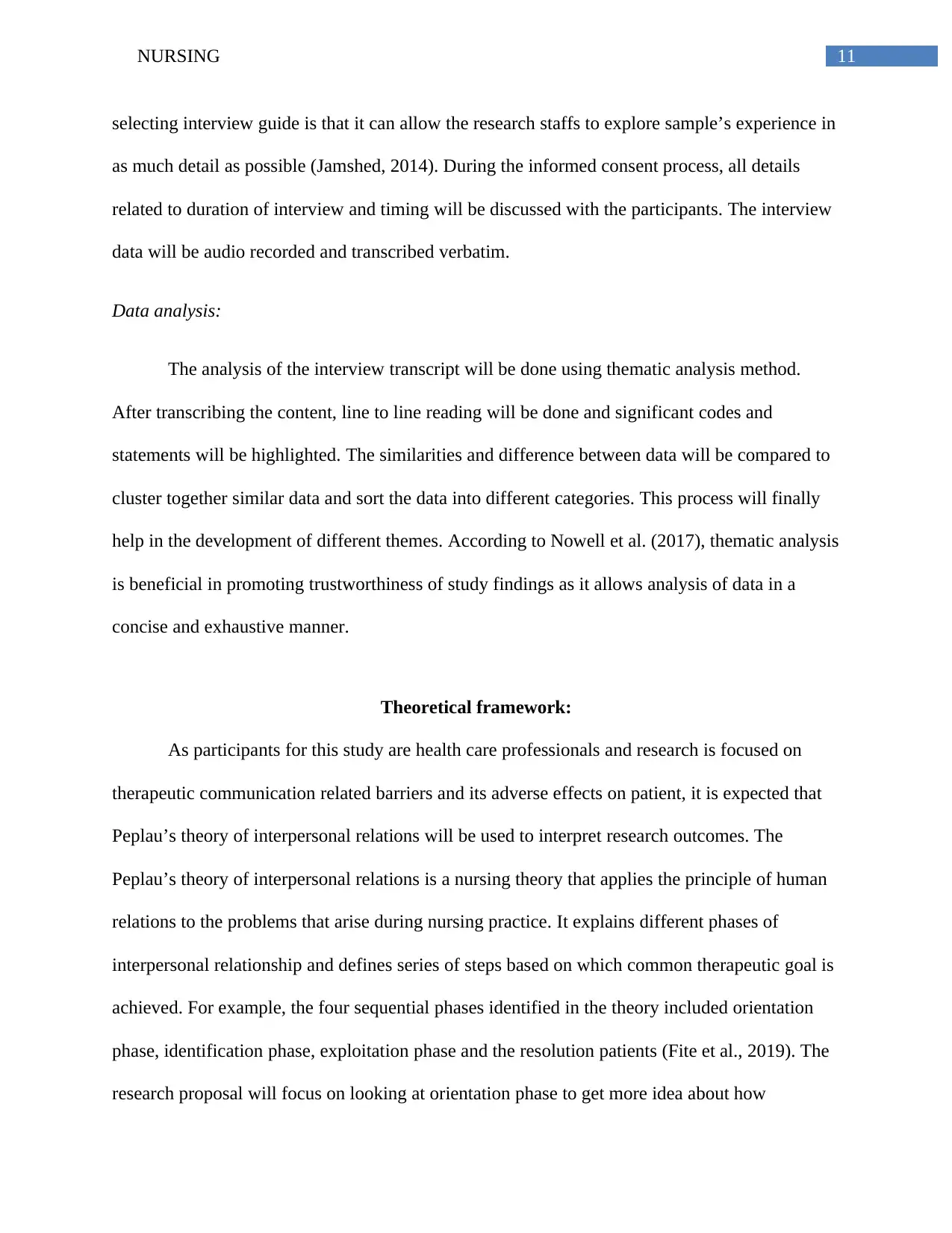
11NURSING
selecting interview guide is that it can allow the research staffs to explore sample’s experience in
as much detail as possible (Jamshed, 2014). During the informed consent process, all details
related to duration of interview and timing will be discussed with the participants. The interview
data will be audio recorded and transcribed verbatim.
Data analysis:
The analysis of the interview transcript will be done using thematic analysis method.
After transcribing the content, line to line reading will be done and significant codes and
statements will be highlighted. The similarities and difference between data will be compared to
cluster together similar data and sort the data into different categories. This process will finally
help in the development of different themes. According to Nowell et al. (2017), thematic analysis
is beneficial in promoting trustworthiness of study findings as it allows analysis of data in a
concise and exhaustive manner.
Theoretical framework:
As participants for this study are health care professionals and research is focused on
therapeutic communication related barriers and its adverse effects on patient, it is expected that
Peplau’s theory of interpersonal relations will be used to interpret research outcomes. The
Peplau’s theory of interpersonal relations is a nursing theory that applies the principle of human
relations to the problems that arise during nursing practice. It explains different phases of
interpersonal relationship and defines series of steps based on which common therapeutic goal is
achieved. For example, the four sequential phases identified in the theory included orientation
phase, identification phase, exploitation phase and the resolution patients (Fite et al., 2019). The
research proposal will focus on looking at orientation phase to get more idea about how
selecting interview guide is that it can allow the research staffs to explore sample’s experience in
as much detail as possible (Jamshed, 2014). During the informed consent process, all details
related to duration of interview and timing will be discussed with the participants. The interview
data will be audio recorded and transcribed verbatim.
Data analysis:
The analysis of the interview transcript will be done using thematic analysis method.
After transcribing the content, line to line reading will be done and significant codes and
statements will be highlighted. The similarities and difference between data will be compared to
cluster together similar data and sort the data into different categories. This process will finally
help in the development of different themes. According to Nowell et al. (2017), thematic analysis
is beneficial in promoting trustworthiness of study findings as it allows analysis of data in a
concise and exhaustive manner.
Theoretical framework:
As participants for this study are health care professionals and research is focused on
therapeutic communication related barriers and its adverse effects on patient, it is expected that
Peplau’s theory of interpersonal relations will be used to interpret research outcomes. The
Peplau’s theory of interpersonal relations is a nursing theory that applies the principle of human
relations to the problems that arise during nursing practice. It explains different phases of
interpersonal relationship and defines series of steps based on which common therapeutic goal is
achieved. For example, the four sequential phases identified in the theory included orientation
phase, identification phase, exploitation phase and the resolution patients (Fite et al., 2019). The
research proposal will focus on looking at orientation phase to get more idea about how
⊘ This is a preview!⊘
Do you want full access?
Subscribe today to unlock all pages.

Trusted by 1+ million students worldwide
1 out of 18
Related Documents
Your All-in-One AI-Powered Toolkit for Academic Success.
+13062052269
info@desklib.com
Available 24*7 on WhatsApp / Email
![[object Object]](/_next/static/media/star-bottom.7253800d.svg)
Unlock your academic potential
Copyright © 2020–2025 A2Z Services. All Rights Reserved. Developed and managed by ZUCOL.





